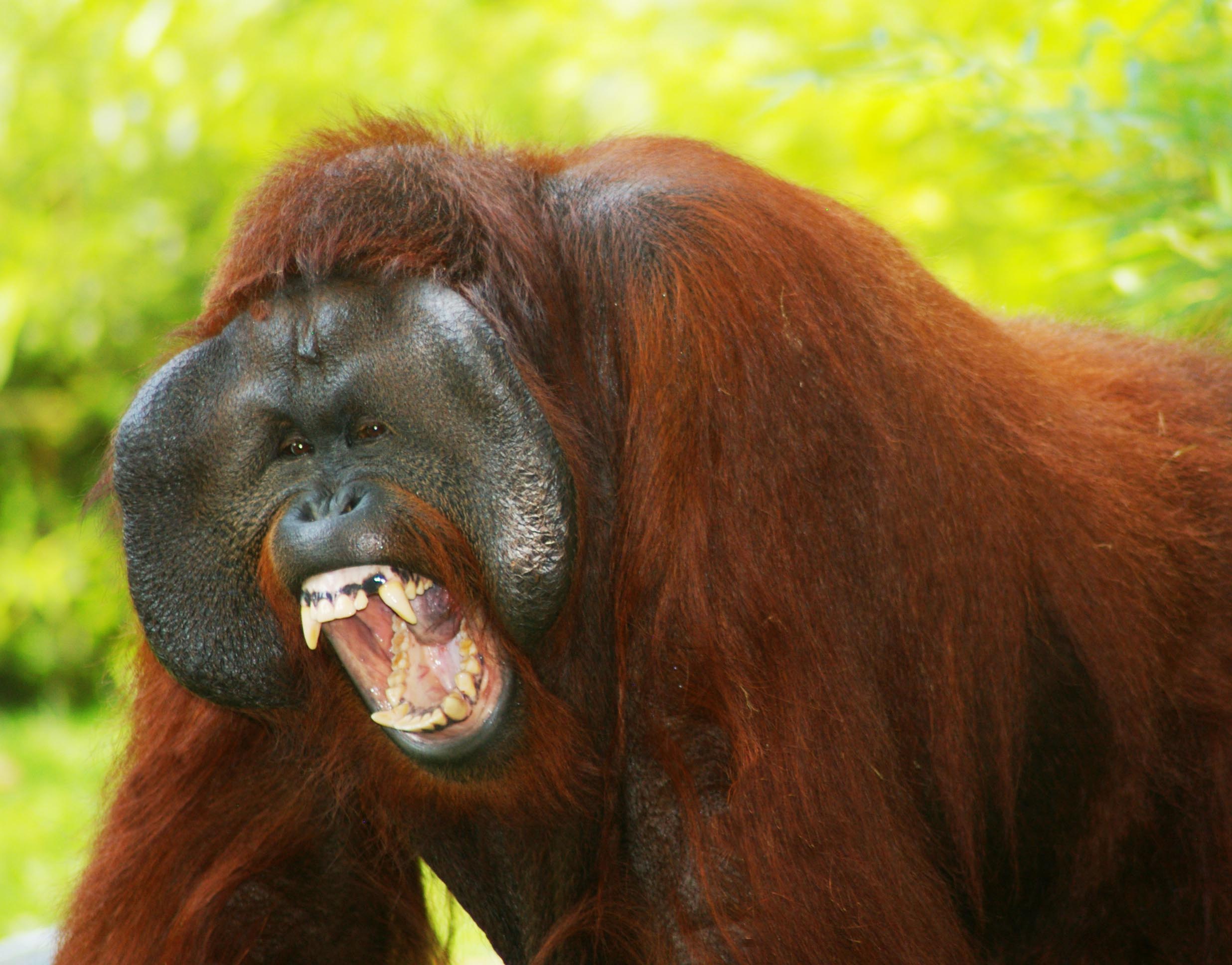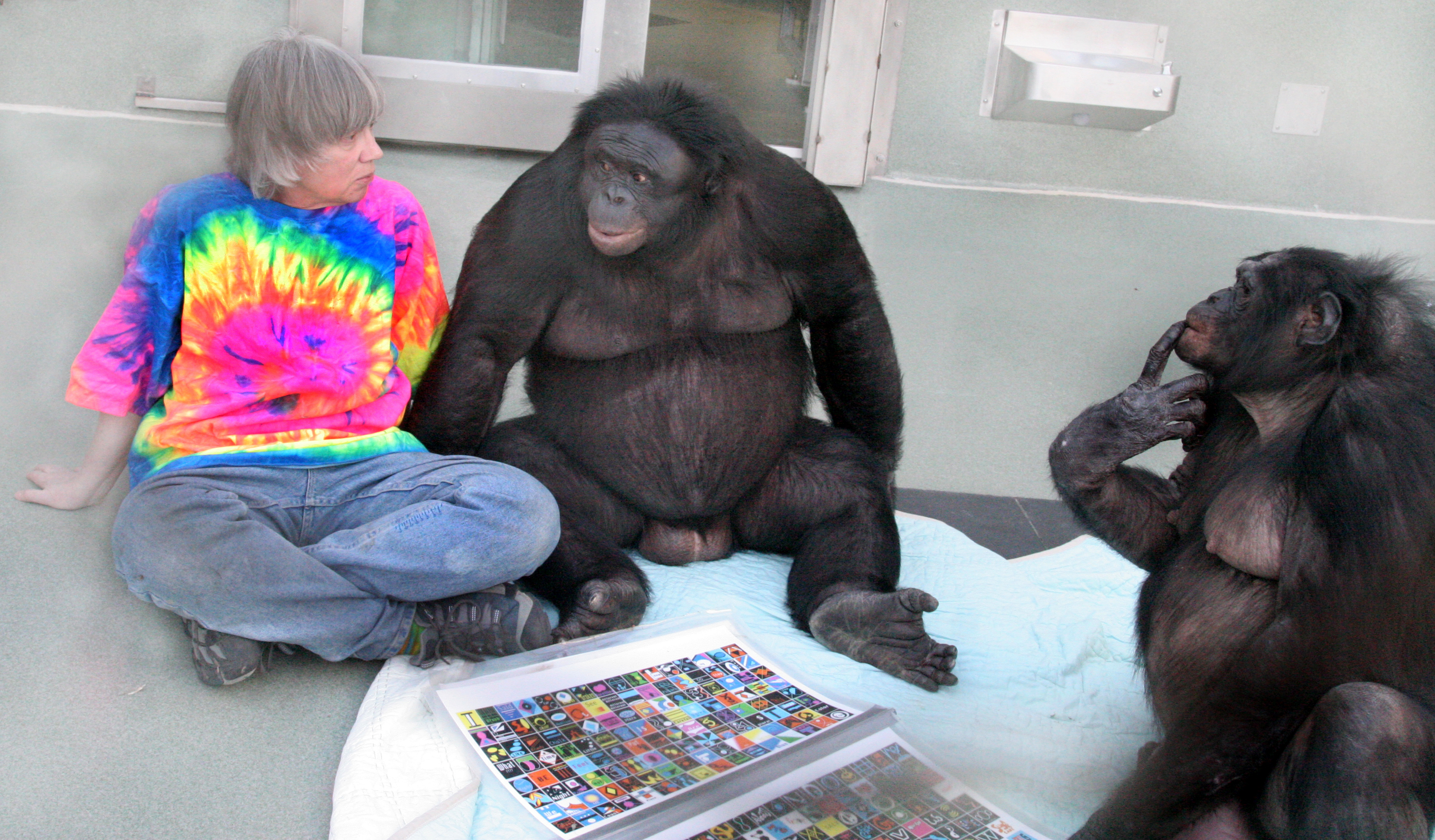|
Lexigram
Yerkish is an artificial language developed for use by non-human primates. It employs a keyboard whose keys contain ''lexigrams'', symbols corresponding to objects or ideas. Lexigrams were notably used by the Georgia State University Language Research Center to communicate with bonobos and chimpanzees. Researchers and primates were able to communicate using lexigram boards made in up to three panels with a total of 384 keys. Context The Yerkish language was developed by Ernst von Glasersfeld and used by Duane Rumbaugh and Sue Savage-Rumbaugh of Georgia State University while working with primates at the Yerkes National Primate Research Center of Emory University in Atlanta, Georgia. Primates were taught to communicate by means of a lexigram board, a computerized array of keys labeled with lexigrams. Von Glasersfeld coined the term "lexigram" in 1971, created the first 120 of them, and designed the grammar that regulated their combination. This artificial language was called ... [...More Info...] [...Related Items...] OR: [Wikipedia] [Google] [Baidu] |
Panbanisha
Panbanisha (November 17, 1985 – November 6, 2012), also known by the Yerkish#Lexigram_concept, lexigram , was a female bonobo that featured in studies on great ape language by Professor Sue Savage-Rumbaugh. Her name is Swahili language, Swahili for "to cleave together for the purpose of contrast." Biography Panbanisha was born at Language Research Center at Georgia State University in Atlanta, Georgia, United States. Panbanisha was the daughter of Matata, the adopted mother of the famous Kanzi, who also was an intelligent bonobo, and was the mother of two sons, Nyota (Bonobo), Nyota and Nathen. Panbanisha resided at the Great Ape Trust in Iowa, where ape behavior and intelligence is studied. She was able to express her sadness through Yerkish when her half-brother Kanzi had to leave. During the studies, Dr. Savage-Rumbaugh had recognized the ability of communication and understanding of complex sentences. She died of a common cold, cold at the Great Ape Trust on Novembe ... [...More Info...] [...Related Items...] OR: [Wikipedia] [Google] [Baidu] |
Kanzi
Kanzi (October 28, 1980 – March 18, 2025), also known by the lexigram (from the character 太), was a male bonobo who was the subject of several studies on great ape language. According to Sue Savage-Rumbaugh, a primatologist who has studied the bonobo since the 1990s, Kanzi exhibited advanced linguistic aptitude. Biography Kanzi was born to Lorel and Bosandjo at Yerkes Field Station at Emory University in 1980. Shortly after birth, Kanzi was stolen and adopted by a more dominant female, Matata, the matriarch of the group. In 1985, Kanzi was moved to the Language Research Center at Georgia State University. He was later relocated, along with his sister, Panbanisha, to the Great Ape Trust, in Des Moines, Iowa. The ill-fated facility, founded in 2004 by local businessman, Ted Townsend, closed after losing funding, experiencing allegations of neglect, and a flood. In 2013, the Ape Cognition and Conservation Initiative (ACCI), under the direction of Jared Tagl ... [...More Info...] [...Related Items...] OR: [Wikipedia] [Google] [Baidu] |
Great Ape Language
Great ape language research historically involved attempts to teach chimpanzees, bonobos, gorillas, and orangutans to communicate using imitative human speech, sign language, physical tokens and computerized lexigrams. These studies were controversial, with debate focused on the definition of language, the welfare of test subjects, and the anthropocentric nature of this line of inquiry. The consensus among linguists remains that language is unique to humans. Contemporary research has steered away from attempting to teach apes human language and focuses instead on observing apes' intraspecies communication in zoos and natural habitats. This includes gestures, facial expressions, and vocalizations. 1890s: Richard L. Garner Richard Lynch Garner was the first researcher to explore in depth the communication skills of nonhuman primates. He began in 1884 studying monkeys in American zoos and later travelled to Africa to study gorillas and chimpanzees. He wrote frequently for ... [...More Info...] [...Related Items...] OR: [Wikipedia] [Google] [Baidu] |
Lana (chimpanzee)
Lana (October 7, 1970 - November, 2016) was a female chimpanzee, the first to use lexigrams in language research. She was born at the Yerkes National Primate Research Center of Emory University, and the project she was allocated to when 1 year old, the LANguage Analogue project led by Duane Rumbaugh, was named after her with the acronym LANA because the project team felt that her identity was well worth preserving.(Rumbaugh, 1977, p. XXI) LANA project The researchers stated that Lana could discriminate between lexigrams, sequence words grammatically and make novel utterances, demonstrating language learning. The first LANA project (1971) officially had two Principal Investigators, Rumbaugh and Ernst von Glasersfeld (cf. NIH grants HD-06016 and RR-00165). Ernst von Glasersfeld developed the language that Lana learned to use: he coined the term "lexigram", created the first 120 of them and designed the grammar that regulated their combination. This artificial language was c ... [...More Info...] [...Related Items...] OR: [Wikipedia] [Google] [Baidu] |
Animal Language
Animal languages are forms of animal communication, communication between animals that show similarities to human language. Animals communicate through a variety of signs, such as sounds and movements. Sign language, Signing among animals may be considered a form of language if the inventory of signs is large enough, the signs are relatively arbitrary, and the animals seem to produce them with a degree of volition (as opposed to relatively automatic conditioned behaviors or unconditioned instincts, usually including facial expressions). Many researchers argue that animal communication lacks a key aspect of human language, the creation of new patterns of signs under varied circumstances. Humans, by contrast, routinely produce entirely new combinations of words. Some researchers, including the Linguistics, linguist Charles F. Hockett, Charles Hockett, argue that human language and animal communication differ so much that the underlying principles are unrelated. Accordingly, linguist ... [...More Info...] [...Related Items...] OR: [Wikipedia] [Google] [Baidu] |
Sue Savage-Rumbaugh
Emily Sue Savage-Rumbaugh (born August 16, 1946) is a psychologist and primatologist most known for her work with two bonobos, Kanzi and Panbanisha, investigating their linguistic and cognitive abilities using lexigrams and computer-based keyboards. Originally based at Georgia State University's Language Research Center in Atlanta, Georgia, she worked at the Iowa Primate Learning Sanctuary in Des Moines, Iowa from 2006 until her departure in November 2013. Early life, family and education Savage-Rumbaugh earned her BA degree in psychology at Southwest Missouri State University in 1970. She earned her MS degree and her Ph.D. in psychology at the University of Oklahoma in 1975. She has collaborated alongside her ex-husband, renowned comparative psychologist Duane M. Rumbaugh, who was a pioneer in the study of ape language. Career Savage-Rumbaugh was a professor and researcher in Atlanta at Emory University's Yerkes Primate Center for twelve years. She was subsequently a pro ... [...More Info...] [...Related Items...] OR: [Wikipedia] [Google] [Baidu] |
Language
Language is a structured system of communication that consists of grammar and vocabulary. It is the primary means by which humans convey meaning, both in spoken and signed language, signed forms, and may also be conveyed through writing system, writing. Human language is characterized by its cultural and historical diversity, with significant variations observed between cultures and across time. Human languages possess the properties of Productivity (linguistics), productivity and Displacement (linguistics), displacement, which enable the creation of an infinite number of sentences, and the ability to refer to objects, events, and ideas that are not immediately present in the discourse. The use of human language relies on social convention and is acquired through learning. Estimates of the number of human languages in the world vary between and . Precise estimates depend on an arbitrary distinction (dichotomy) established between languages and dialects. Natural languages are ... [...More Info...] [...Related Items...] OR: [Wikipedia] [Google] [Baidu] |
Georgia State University
Georgia State University (Georgia State, State, or GSU) is a Public university, public research university in Atlanta, Georgia, United States. Founded in 1913, it is one of the University System of Georgia's four research universities. It is also the second largest institution of higher education by enrollment based in Georgia with a student enrollment of around 50,000, including approximately 33,000 undergraduate and graduate students at the main campus Downtown Atlanta, downtown. Georgia State is Carnegie Classification of Institutions of Higher Education, classified among "List of research universities in the United States#Universities classified as "R1: Doctoral Universities – Very high research spending and doctorate production", R1: Doctoral Universities – Very high research spending and doctorate production". The university is the most comprehensive public institution in Georgia, offering more than 250-degree programs in over 100 fields of study spread across 10 acade ... [...More Info...] [...Related Items...] OR: [Wikipedia] [Google] [Baidu] |
Bonobo
The bonobo (; ''Pan paniscus''), also historically called the pygmy chimpanzee (less often the dwarf chimpanzee or gracile chimpanzee), is an endangered great ape and one of the two species making up the genus ''Pan (genus), Pan'' (the other being the common chimpanzee, ''Pan troglodytes''). While bonobos are today recognized as a distinct species in their own right, they were initially thought to be a subspecies of ''Pan troglodytes'', because of the physical similarities between the two species. Taxonomically, members of the chimpanzee/bonobo subtribe Panina—composed entirely by the genus ''Pan (genus), Pan''—are collectively termed ''panins''. Bonobos are distinguished from common chimpanzees by relatively long limbs, pinker lips, a darker face, a tail-tuft through adulthood, and parted, longer hair on their heads. Some individuals have sparser, thin hair over parts of their bodies. The bonobo is found in a area within the Congo Basin of the Democratic Republic of the Con ... [...More Info...] [...Related Items...] OR: [Wikipedia] [Google] [Baidu] |
Nyota (bonobo)
Nyota (pronounced ''en-Yo-ta''; born 1998), also known by the lexigram , is a bonobo. Nyota was born at the Language Research Center at Georgia State University. His mother was Panbanisha and his father was P-suke. With Panbanisha's death on November 6, 2012, Nyota became the sole surviving member of his immediate family. Nyota's name means 'star' in Lingala, a language from the Democratic Republic of Congo, Africa. Nyota was reared by Panbanisha and Kanzi with primatologists Sue Savage-Rumbaugh and William M. Fields. , July 8, 2006. Retrieved 2010-04-15. As a precocious youngster in 2004, Nyota is instrumental to researchers investigating the cross-generational effects of langu ... [...More Info...] [...Related Items...] OR: [Wikipedia] [Google] [Baidu] |
Ernst Von Glasersfeld
Ernst von Glasersfeld (March 8, 1917, Munich – November 12, 2010, Leverett, Massachusetts, Leverett, Franklin County, Massachusetts) was a philosopher, and emeritus professor of psychology at the University of Georgia, research associate at the Scientific Reasoning Research Institute, and adjunct professor in the Department of Psychology at the University of Massachusetts Amherst. He was a member of the board of trustees of the American Society for Cybernetics, from which he received the McCulloch Memorial Award in 1991. He was a member of the scientific board of the Instituto Piaget, Lisbon. Glasersfeld is known for the development of radical constructivism. Biography Glasersfeld was born in Munich, where his father, Leopold, worked as a cultural attaché in Vienna before going into photography after World War I. He was a student of mathematics at the University of Vienna before having to move out because of the Nazi threat, considering that his Pan-European identity, Pan-E ... [...More Info...] [...Related Items...] OR: [Wikipedia] [Google] [Baidu] |





